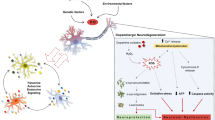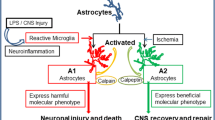Abstract
Parkinson’s disease is a neurodegenerative disease characterised by a massive loss of dopaminergic neurons in the substantia nigra. Yet glial cells may also participate in the pathophysiology of the disease. Indeed, glial cells can produce trophic factors which may stimulate neuronal survival or, alternatively, they could produce toxic compounds which may be involved in neuronal degeneration. This paper reviews the potentially protective or deleterious effects of glial cells in the substantia nigra of patients with Parkinson’s disease.
Similar content being viewed by others
Author information
Authors and Affiliations
Rights and permissions
About this article
Cite this article
Hirsch, E. Glial cells and Parkinson’s disease. J Neurol 247 (Suppl 2), II58–II62 (2000). https://doi.org/10.1007/PL00007762
Issue Date:
DOI: https://doi.org/10.1007/PL00007762




